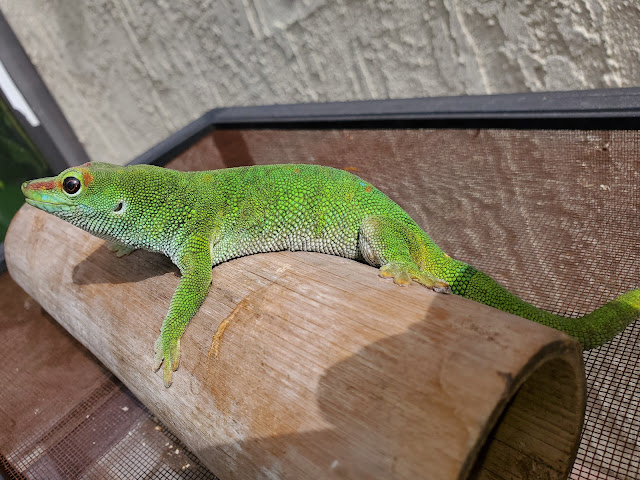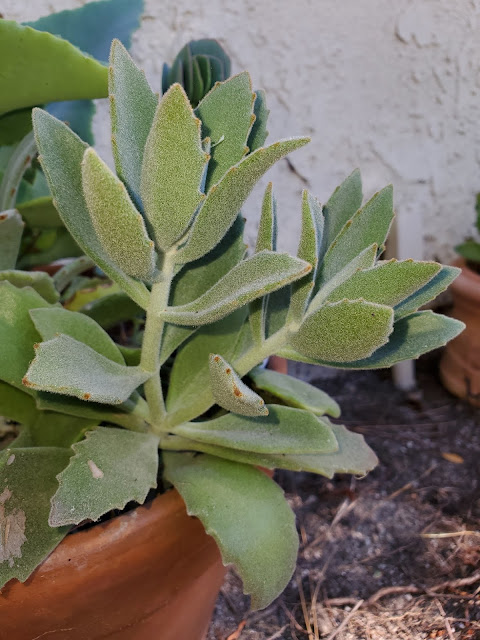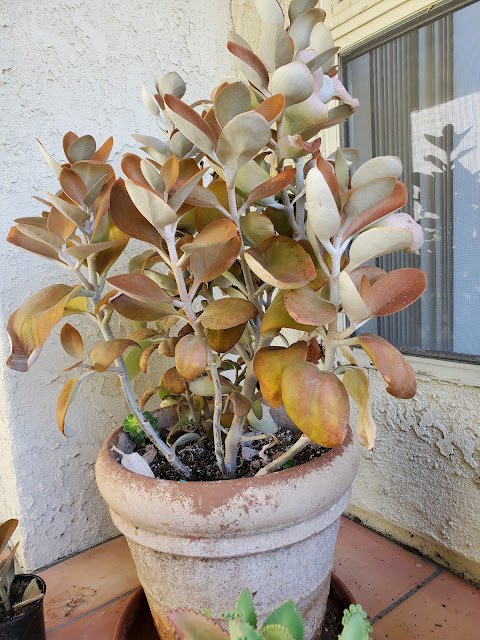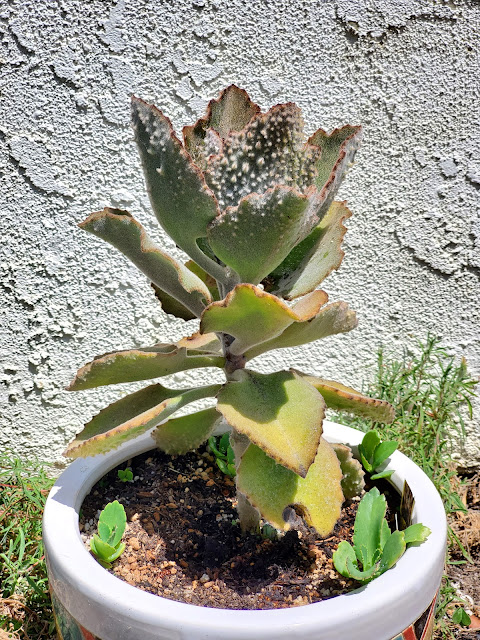When we last saw this little fellow, Kalanchoe marmorata, back in May, he was a big, fleshy bedding plant with presence but not that Kalanchoe oomph.
Guess what. It's flowering season, and he's showing normal Kalanchoe behavior.
When we last saw this little fellow, Kalanchoe marmorata, back in May, he was a big, fleshy bedding plant with presence but not that Kalanchoe oomph.
Guess what. It's flowering season, and he's showing normal Kalanchoe behavior.
 |
| Bonfire image created with https://creator.nightcafe.studio/ |
My writing class prompt this week was to write about Halloween. I did a Halloween story last year and I didn’t want to write about Halloween this year. We didn’t celebrate it growing up (although it’s taken off in the UK now). Our celebration was called Bonfire Night, November the 5th. People nowadays light bonfires in memory of Guy Fawkes, who tried to blow up the Houses of Parliament in 1605. A human effigy, called a Guy, is placed on top of the bonfire. However, the tradition dates back to the Celtic feast of Samhain, when the veil between the spirit world and our world is thin.
Note: A Recce is a recreation area [play area for kids]. An
allotment is a personal garden that is not attached to a house.
#
“Penny for the Guy,” Mark says hopefully.
The shopper turns and stares at the boys sitting on the flagstones
in front of Woolworths. “Call that a Guy? It’s just trousers and a cardigan sewn
on a pillow.”
“Ain’t got no money,” Andy explains. Andy’s body has begun
the process of growing up. At eleven he’s almost a foot taller than the two
ten-year-olds beside him.
“If you buy a Guy Fawkes mask for it, I’ll give you fifty
pee.”
“Wor, fanks,” Andy says, catching the heavy coin.
“Bonfire night’s tonight,” she says. “Get a shift on.”
When she’s out of earshot, Andy says to Sid, “Nick a mask
from Woolies. Save us a bob or two we can spend on fireworks.”
“I’m not nicking noffink,” Sid says. “Buy a mask, and me
sister will sew a pillow for the head and put the mask on it and we’ll be
laughin’.”
“He’ll burn good and proper,” Mark says.
“We need more wood for the bonfire,” Sid says. “I know an
empty house with wooden floors.”
*
The bonfire is behind Mark’s house, in a Recce near the
allotments. There’s nothing nearby
except clumps of Fireweed that sprang up after last year’s celebration. Sid’s
mum has a shed in her allotment, and that’s where they keep the fireworks.
As Mark arrives with the last armful of floorboards, Sid and
Andy are arguing. Sid’s refusing to put his new-found floorboards against the
half-built cone.
“Me Dad said you shouldn’t actually build the bonfire until
day of,” Sid was explaining. “We have to move it and pile the wood up again.”
“It’ll take too long,” Andy replies.
“Day of. Or it’s bad luck or sa’ink, I dunno. But me dad said…”
“Your dad’s dead,” Mark says.
Instantly, Sid’s eyes redden. “What’s that got to do wiv it?
Being dead don’t make you wrong.”
Seeing the smaller kid about to cry, Andy switches sides. “Come
on, Mark. Maybe Sid’s dad has a point.”
“Had,” Mark says, sotto voce. Sid doesn’t notice.
“How far are we moving it?” Andy says.
“He just said ‘build it on the 5th, not before,’”
Sid says.
“Move it…what…six feet toward the house. That way we can use
a pallet as the new base.”
Andy drops a wood pallet in the new spot. The kids grab the
wood and start building a new cone.
“Fuckin’ ‘ell,” Sid suddenly shouts. “I caught me hand on a
nail.”
“You should wear gloves,” Andy says from his lofty height.
Sid feels between the two planks. “It’s not a nail.” He
reaches into the dark interior of the woodpile. Rolls something out.
“It’s a hedgehog,” Mark says.
“I can see that,” Sid says.
“It’s all in a spiked ball, like in a kid’s book.”
“I can see that,” Sid says.
“You have to take it home and feed it milk and bread,” Andy
says.
“Why? I don’t think mummy and daddy hedgehog fed it milk and
bread,” says Sid.
“Hedgehogs are mammals,” Mark says, knowledgeably. “They eat
milk.”
“I’ll put it in a cardboard box in the shed,” Sid says.
“Until the fires are all out and the smoke’s gone.”
“That’s what your dead dad meant, innit,” Mark says. “He meant don’t burn wood until you know what’s under it.”
Sid nods and resumes stacking floorboards on the new pile.
It’s getting dark. In two hours, Sid’s sister will bring out the Parkin and Bonfire Toffee. His Mum will open the box of fireworks and hand out sparklers to the little ones.
#
I normally feature The House on the Hill Opposite That Lights Up at Dawn during February, when it lights up at dawn to presage the coming of spring.
Of course, it also lights up at dawn just before fall starts in earnest, in mid-October. Many Ides of October are overcast here in So Cal and so the viewing isn't as good. It's been misty in the early morning for weeks, and just recently it rained for a solid day. (It started approximately an hour after I finished planting our mandatory drought-resistant plants, which replaced our lawn. Good luck with avoiding root rot, my little Kalanchoe friends!)
But it cleared up on Monday, so today and yesterday were the days The House on the Hill Opposite That Lights Up at Dawn to presage the coming of Autumn.
 |
| HOTLUAD |
 |
| HOTLUAD |
You can see from the telephoto shot that the debris around the house, the number of broken windows and the slope erosion are all getting worse. The upper floor is still poised to Light Up at Dawn, though and the last time we visited the property, it looked like the slab was in good condition. May it continue to presage the autumn. (And spring.)
 |
| HOTLUAD Today |
A Man Said to the Universe
I'm pleased to let you know that my short story "Jump Jiving" is published in the Spring 2022 edition of Eldritch Science, the magazine of The National Fantasy Fan Federation (N3F), edited by George Phillies.
Singer Eric Barker knows Swing Revivals are inevitable, but infrequent. His Swing band skips decades at a time in Cryogenic Sleep. After an unprecedented 150 years, Eric wakes to find there are no longer any Billboard music charts, no Variety, no streaming services, no vinyl. Who has paid for them to play in a world that doesn't buy music?
You can read a free PDF of Eldritch Science here. It's packed full of great stories - a bumper edition! "Jump Jiving" starts on page 45.
 |
"The usual explanation of how we got these stupendously complex organs rests upon the theory of natural selection. You may recall the gist from school biology lessons. If a creature with poor eyesight happens to produce offspring with slightly better eyesight, thanks to random mutations, then that tiny bit more vision gives them more chance of survival. The longer they survive, the more chance they have to reproduce and pass on the genes that equipped them with slightly better eyesight. Some of their offspring might, in turn, have better eyesight than their parents, making it likelier that they, too, will reproduce. And so on. Generation by generation, over unfathomably long periods of time, tiny advantages add up. Eventually, after a few hundred million years, you have creatures who can see as well as humans, or cats, or owls. This is the basic story of evolution, as recounted in countless textbooks and pop-science bestsellers."
He goes on, "The problem, according to a growing number of scientists, is that it is absurdly crude and misleading. For one thing, it starts midway through the story, taking for granted the existence of light-sensitive cells, lenses and irises, without explaining where they came from in the first place."
 |
| Mrs. F being miserable in her temporary cage |
Khachaturian (Mr K for short) is a Jackson's Chameleon. It's not his birthday. But behind him, being almost invisible, is his wife, Mrs K. She was one year old in April. It's not long since I saw her being born. (Jackson's are live-bearing; they don't lay eggs.) She's certainly grown into a big, bossy adult but it's the male of the species that has the spectacular looks.
Ms F at a few days old - well, it could be her. She was in a plastic tote with her brothers and sisters.
My Grandis Day Gecko - formerly known as a Geico Gecko - was 26 this month. At least, that's his observed birthday. His vet records show him as an adult in late 1996 and he was fully grown at least a few months before that, when I got him.
Books generally say Phelsuma grandis lives around 13 years, but Mr F has beaten those odds. He's not exactly in prime condition, I have to admit. He's been blind for years and we hand feed him with fruit-based Crested Gecko food. (Day Geckos love fruit as well.) He seems to mostly enjoy life. His favorite things are warmth, sticking to vertical glass surfaces, hiding in bamboo tunnels and fruit-based gecko food. He had all of these things for his birthday party.
Happy Birthday, Mr. F!
 |
| Mr F sitting on his bamboo hide-away |
Hopwood Hall.
According to the BBC, Hopwood Hall, built in the 1420s, is being restored by an American, Hopwood DePree.
I've forgotten what my part of the family's association is with Hopwood Hall - ISTR the name coming from service there, rather than being the owners - but I'm glad a Hopwood has come forward to restore it. It seems he thought it would be a fun thing to do, but found it intricate and tedious. Still, he's sticking with it. Part of it is opening for tours this month. Sadly, I'm where DePree is from - I'm near LA, he's back in Lancashire.
 |
Correspondent Kyle lets me know that the plant labeled K. millotii which I described here is most probably Kalanchoe x gildenhusii. That's a hybrid of K. millotii and K. tomentosa, and explains why it's showing characteristics intermediate between the two.
Here's the page on the International Crassulaceae Network with the deets.
Mine was labeled (incorrectly) as K. millotii. Kyle says that this hybrid is often sold under the invalid name Kalanchoe 'Behartii'.
 |
Egrets
I've had a few
But then again, too few to mention.
Birds on hay bales, near the Salton Sea.
They may not be egrets. I'm no birder.
 |
| (Not mine - I nicked it from Facebook.) |
“If he’s standing between her and the window, against the light, how could she see the gleam of a knife in his hand?”
I said I was getting a new Kalanchoe - here it is. It's a dwarf K. beharensis. According to the label, it'll grow to about 3 feet (a meter) high and slightly less than that in spread. Mind you, according to the label, it's a "Fang". It clearly isn't a Fang - there are no under-leaf tubercles in sight. The previous owner has written 2020 on the label, and it's apparently over five years old. It's going to look a little small in a barrel close to the tree-form beharenses but its abundant curly foliage should more than make up for its size.
Last but not least, I have a Kalanchoe longiflora, a relatively common South African succulent that is grown for its spray of long-lasting flowers. The one I got has not grown or divided much at all over the course of a year, nor has it flowered, but it's sitting there looking quite pretty. It's the red plant at the back, behind the K. fedtschenkoi. (The tiny stalky ones are baby Pink Butterflies, which get everywhere.)
 |
More information can be found here.
(I say last but not least, but I'm getting a new plant tomorrow...possibly more to come!)
One unusual Kalanchoe is K. marnieriana. The leaves are rounder than usual, the stalks longer and thinner, and the plant grows roots along its length, allowing it to lie on the ground and creep across to new places to live.
It was sold as a ground cover, in a flat. I grew it in a pot and wasn't impressed but this year it seems to have settled down and filled the pot nicely. It will get long and leggy (as Kalanchoes tend to do) but it's easy to cut it back and it starts again from the rootstock.
 |
One resource is Gardenia.net.
One Kalanchoe I have looks like a K. diagremontiana but has a black border on the leaves. It was labeled "John Bleck". I couldn't find much information on the web about it, but here is the nursery's description. It seems John Bleck is or was a big cheese in the Santa Barbara Cactus & Succulent Society. His name is associated with several hybrids and articles on the Crassulaceae.
He made a very pretty plant. It did, however, do the Kalanchoe thing and get weedy, leggy and huge - about a meter and a half tall - flower, and then die back slowly. I cut the tops off and this nice thicket grew up within a few weeks.
Although it doesn't grow rooted plantlets along the leaf margins while the leaves are on the plant, if the leaf falls in the soil before it dies, plantlets grown from it. Quite a few grew last year. (They're in a separate pot.) By the end of the year, I should have enough to make a beautiful display.
Here is a line-up of "classic" Kalanchoe shapes.
Mother of Thousands----Mother of Millions----Pink Butterflies
All of these are young plants, less than a year old. The tiles are 25 cm in length. See the individual posts for details.
I started collecting the Kalanchoes because I'd had a Mother of Thousands as a kid. Once I started looking for them as an adult, I realized that commercial nurseries don't always know which Kalanchoe species they are selling. There is apparently a lot of confusion over which of the stalky, leggy, classical Kalanchoes are which.
Mother of Thousands is often said to be K. diagremontiana and you'll see it pictured as having broad, pale green leaves, for example here. As far as I know, that appearance is more typical of K. laetivirens, which means "green all over." Laetivirens is a hybrid of K. diagremontiana and K. laxiflora.
I have another plant said to be K. diagremontiana which is most likely a different hybrid, Kalanchoe x houghtonii, which I wrote about earlier.
Pictured below, my most-probably x laetivirens.
 |
K. tomentosa, the Panda Plant, is a pretty, furry, compact succulent that can be grown indoors or outside if you live in a warm area. (I'm in Southern California.)
The edges of the leaves have contrasting dark brown spots, making for a striking display plant. Mine have grown considerably but aren't bolting or putting down many plantlets.
You can find tips on K. tomentosa on the web. I looked at Gardening Know-How and World of Succulents.
Kalanchoe millottii is a pale green, furry succulent that stays quite small. It's the one nearest the camera in the photo below. It has pleasing scalloped leaf edges and thick succulent leaves. So far it is making a good effort to form a little clump of plants. It's less than 25 cm tall. It hasn't flowered (in a year) and is showing no signs of bolting yet.
On the other hand, the new leaves (to the upper left) are not the same shape. They resemble K. tomentosa. No idea if every specimen does this or if it's just mine.
(Update: it's probably a hybrid between the two - see here for details. Thanks, correspondent Kyle.)
Important care tips for millotii can be found at World of Succulents. To which I'd add: don't get water on the felted leaves when it's sunny. You can see the leaf damage that results on the far leftmost leaf.
(The other plants visible in the pot are K. beharensis Blue Slick and K. Marnieriana, about which more elsewhere.)
There's a regularly-seen Kalanchoe called Lavender Scallops. Its pink-and-pale-green foliage makes for a pretty display in succulent gardens or in pots. It grows about 30 cm high and forms comely clumps. It pales (no pun intended) in comparison with its compact form. This tiny plant has the same leaves, but they remain upturned forming a scalloped cylinder.
If you're in the right zones to grow Kalanchoes outside, a midsize beauty is Copper Spoons, Kalanchoe orgyalis. It's another furry plant, so it's sometimes known as Cinnamon Bear and rather less glamorously, the Shoe Leather Plant.
It grows to about a meter, three feet, high and doesn't lose the lower leaves. (Well, it didn't until I let it get sunburned during a heatwave.) It's a striking plant that requires little care and unlike some Kalanchoes, doesn't go leggy and horrible at the end of the year.
 |
| Copper Spoons |
This is such a lovely and long lasting plant that when I saw a variety of it called Grey Ghost, I immediately took it home with me.
Grey Ghost looked ghostly and great for a few months and then turned into another Copper Spoons. I don't know if that always happens. There's no information on it I can find on the internet, but the nursery label was professionally done, not a handwritten guess. The plant is still a beauty.
 |
| Grey Ghost |
You can see that the lower leaves are still grey, but the top is distinctly cinnamon. This is a plant that has not read its own label.
Not closely related is the much more delicate Silver Spoons, Kalanchoe bracteata or Kalanchoe hildebrantii.
One of the most spectacular Kalanchoes is K. gastonis-bonnieri. (Its name is as impressive as the plant.) Like a Mother of Thousands, it bears plantlets on its leaves. Not a whole row, like the mother, but one or two at the very tip. And the leaf itself is often over 25 cm long. They really do look like Donkey Ears, if donkeys had thick, green, hairless ears.
My current ones are still babies, with small, rounded seedling leaves. Here's a picture of their mother, late last year, during flowering.
 |
| Kalanchoe gastonis-bonnieri, Donkey Ears |
 |
| Eight month old Donkey Ears |
I found further information on Donkey Ears at Plant Care Today.
I saw a Kalanchoe marmorata on sale and it sounded like a good idea at the time. It means "marbled" and the name gives the impression of a stately, expensive-looking plant. It turned out to be a bedding plant that I haven't found a way to display properly yet, so forgive the boring-looking presentation.
Those tiles are a foot across, so you can see this a a large-leaved plant that would look good in a border. It's shown no sign of bolting or flowering yet, but Kalanchoes do tend to suddenly shoot upwards and ruin an arrangement. I'll let you know if it does. The marbling is a little dull, but again probably interesting en masse. It's known as the Penwiper plant, or Penwipe. I have no idea why.
 |
| Scarred leaf of marmorata |
Another plant was sold to me as a marmorata, but it never grew bigger than its 4" pot. Eventually it put out a spray of beautiful flowers that lasted for months. Of course, I didn't take a photo of the flowers and eventually I cut the plant back to bring out the plantlets.
I'm sure it's a Kalanchoe humilis. Same marbled leaves, but about 15 cm shorter.
I'm sorry I butchered you, little humilis. In a year or so I'll be able to separate the plantlets and hopefully get more sprays of lovely flowers.
I got more information on humilis from Succulents and Sunshine, though they do call it a "large shrub". I don't call a foot-tall plant a shrub, myself. More information on marmorata can be found at World of Succulents.
Spent the day in the yard. So did the insects.
A Plague of Locust on the beans. These huge grasshoppers are a nuisance around here, mostly because they're too large for my Jackson's chameleons to eat. I need to get another giant Veiled male. They loved them.
 |
I wrote about my largest plants, K. beharensis here, the furry Felt Plant, some varieties of which grow to tree size.
 |
| K beharensis Blue Slick rootstock regrown, with plantlets grown from planted leaf |
I bought one Blue Slick a couple of years ago, and when it lost its lower leaves I panicked. (I know now they usually lose the lower leaves.) I cut it up and planted the remaining leaves and the top separately and left the root+stalk in the pot. Every last part of that plant regrew. It's Kalanchoe's superpower!
The roots regenerated two good-looking branches bearing hairless leaves. Each leaf I planted grew a thicket of babies and the top rooted and grew a new plant.
 |
| K beharensis Blue Slick plantlets - they have fur |
The oddest thing is the leaves (which were, well, slick, not furry) grew furry babies. The new plants are almost a year old and have not lost their fur. It's possible that comes later but it's very odd. (Kalanchoe plants that reproduce by offshoots like this are clones. Their genetic material is identical to the parent plant. They don't just change varieties or hybridize like plants sometimes do when they produce seeds with other plants' pollen.)
Now I know that Blue Slick is going to grow huge like its cousin, I'll let it lose lower leaves and continue to grow.
One thing to remember about the deeply-indented leaves, especially furry ones: don't leave drops of water on top of them while they're in the sun. It burns the leaves and the scar never heals over.
I have another variety of K. beharensis called Fang. What appears to be the same thing was also sold to me under the variety name Flag. Both of these have the normal cupped, furry beharensis leaves but with canine-tooth-shaped protuberances on the underside. Since they carry their leaves tipped-up most of the time, it's possible to appreciate their striking looks even when they are quite small.
 |
| Kalanchoe beharensis "Fang" (or "Flag"). The smaller plants are baby Mother of Thousands that fell off Mother. |
 |
| Kalanchoe beharensis "Fang" in pot |
The last variety I have of this species is one I think is marketed as "Oak Leaf". The one I bought just said it was a beharensis, but it grew into this beautiful specimen. I'm guessing that it's an Oak Leaf since the leaves look that way. It's growing quite large but I don't know if it'll reach the tree-level heights that some K beharensis varieties can. If I've identified it correctly, it's a hybrid, Kalanchoe beharensis with K. millotii. (There are similar varieties, for example those sold as "Silver Strand" (which never give information on variety or hybrid status). This certainly isn't yet "densely branched" so I may change my mind when I see what the flowers look like, if any.)
 |
| Kalanchoe beharensis "Oak Leaf " (probably). (K tomentosa behind and to the left, K hildebrantia behind.) |